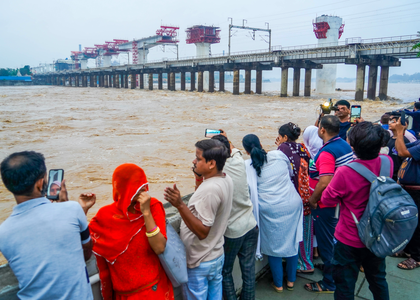'Red alert' issued for heavy rainfall in Gujarat
By IANS | Updated: September 7, 2025 23:10 IST2025-09-07T23:09:49+5:302025-09-07T23:10:06+5:30
Ahmedabad, Sep 7 The India Meteorological Department (IMD) has issued a red alert for parts of Gujarat, warning ...

'Red alert' issued for heavy rainfall in Gujarat
Ahmedabad, Sep 7 The India Meteorological Department (IMD) has issued a red alert for parts of Gujarat, warning of heavy to very heavy rainfall over the next 48 hours, particularly in northern districts where the monsoon remains highly active.
According to officials, the alert has been triggered by a persisting low-pressure area and an active monsoon trough.
Districts including Banaskantha, Sabarkantha, Mehsana, Patan, and several parts of Saurashtra-Kutch have been placed under red alert, with the likelihood of extremely heavy rainfall. Ahmedabad, Surendranagar, Kheda, and Patan are also expected to receive heavy downpours, while parts of South Gujarat remain under an orange alert.
The IMD noted that while rainfall intensity may ease after two days, strict caution is advised in the immediate period.
An official said that Gujarat has already recorded 23 per cent above-average rainfall this monsoon season. Fishermen have been warned against venturing into the sea due to rough conditions.
Earlier forecasts had also pointed to widespread rainfall across nearly the entire state, covering Banaskantha, Ahmedabad, Vadodara, Surat, Narmada, Bharuch, Navsari, Valsad, Tapi, and Dang, as well as Rajkot, Jamnagar, Junagadh, Bhavnagar, Kutch, and Dwarka in the Saurashtra-Kutch region. The monsoon trough currently extends from Ganganagar to northeast Bay of Bengal, with a cyclonic circulation active over the Bay and adjoining Myanmar coast.
Gujarat’s rainfall pattern in 2025 has been marked by both abundance and uneven distribution, shaping the state’s agriculture and water storage significantly.
Traditionally water-scarce regions like Saurashtra and Kutch witnessed better-than-expected rains this year, reducing the overall deficit trend seen in past years. Intense spells in July and August, particularly triggered by active low-pressure systems over the Arabian Sea and Bay of Bengal, brought heavy downpours that filled major reservoirs—Sardar Sarovar alone recorded more than 91 per cent storage, while 123 out of 206 reservoirs across the state touched high-alert levels.
At the same time, the rainfall was not evenly spread; several districts faced flooding, crop damage, and waterlogging due to back-to-back heavy spells, whereas others saw intermittent dry days that caused stress to kharif crops. This patchy yet abundant rainfall highlights both the bounty and challenges of Gujarat’s 2025 monsoon, reflecting a broader trend of climate variability impacting regional weather.
Disclaimer: This post has been auto-published from an agency feed without any modifications to the text and has not been reviewed by an editor
Open in app